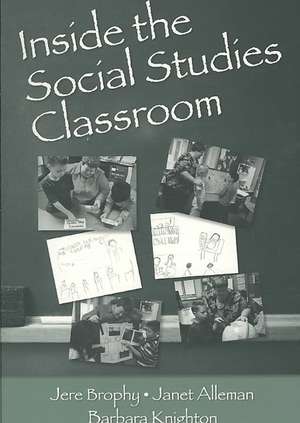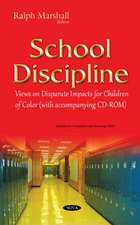Inside the Social Studies Classroom
Autor Jere Brophy, Janet Alleman, Barbara Knightonen Limba Engleză Paperback – 22 iul 2008
"… a much-needed addition to elementary social studies that will move the field ahead."
Keith C. Barton, University of Cincinnati
"This text fills a valuable niche and should quickly become a leading reference for teachers and teacher educators."
Linda S. Levstik, University of Kentucky
This book, resulting from a collaboration among an educational psychologist, a social studies educator, and a primary teacher, describes in rich detail and illustrates with excerpts from recorded lessons how primary teachers can engage their students in social studies lessons and activities that are structured around powerful ideas and have applications to their lives outside of school. The teaching portrayed connects concepts and skills emphasized in national and state standards, taught in ways that build on students’ prior experiences in their local communities and connect with their family backgrounds and home cultures.
The analyses include rich descriptions of the teacher-student interactions that occur during lessons, detailed information about how and why the teacher adapted lesson plans to meet her students’ background experiences and adjusted these plans to take advantage of teachable moments that emerged during lessons, and what all of this might imply concerning principles of practice. The principles are widely applicable in elementary schools across the country, as well as across the curriculum (not just in social studies) and across the elementary grades (not just the primary grades).
| Toate formatele și edițiile | Preț | Express |
|---|---|---|
| Paperback (1) | 494.39 lei 6-8 săpt. | |
| Taylor & Francis – 22 iul 2008 | 494.39 lei 6-8 săpt. | |
| Hardback (1) | 1276.52 lei 6-8 săpt. | |
| Taylor & Francis – 22 iul 2008 | 1276.52 lei 6-8 săpt. |
Preț: 494.39 lei
Nou
Puncte Express: 742
Preț estimativ în valută:
94.61€ • 98.41$ • 78.11£
94.61€ • 98.41$ • 78.11£
Carte tipărită la comandă
Livrare economică 14-28 aprilie
Preluare comenzi: 021 569.72.76
Specificații
ISBN-13: 9780805855722
ISBN-10: 0805855726
Pagini: 316
Ilustrații: 12 tables
Dimensiuni: 152 x 229 x 23 mm
Greutate: 0.58 kg
Ediția:1
Editura: Taylor & Francis
Colecția Routledge
Locul publicării:Oxford, United Kingdom
ISBN-10: 0805855726
Pagini: 316
Ilustrații: 12 tables
Dimensiuni: 152 x 229 x 23 mm
Greutate: 0.58 kg
Ediția:1
Editura: Taylor & Francis
Colecția Routledge
Locul publicării:Oxford, United Kingdom
Cuprins
CHAPTER 1. INTRODUCTION
Need for Improving Primary Social Studies
Our Partnership
Searching for a Feasible Method
Barbara Joins the Team
Negotiating Understandings and Inducing Principles
Focus of the Book
CHAPTER 2. PRIOR RESEARCH ON PRIMARY SOCIAL STUDIES
The Need for a Powerful Content Base In Early Social Studies
The Expanding Communities Sequence
Cultural Universals as Unit Topics
Teaching Cultural Universals for Understanding, Appreciation, and Life Application
Topical Organization of Curriculum
Teaching for Conceptual Change
Addressing Prior Knowledge and Misconceptions
NCSS Standards
Other Research
CHAPTER 3. GENERIC ASPECTS OF OUR INSTRUCTIONAL UNITS
Our Approach Compared to Alternatives
Developing the Unit Plans
Sequencing the Lessons
Pilot Testing and Revisions
Key Characteristics of the Units
Example Unit Outline: Shelter
Incorporating the Units Within the Larger Curriculum
CHAPTER 4 USING NARRATIVE TO BUILD A CONTENT BASE
The Special Challenges of Teaching Young Children
Narrative Structures as Teaching Tools
Barbara’s Use of Narrative
Clothing in the Past
The Story of Bananas
Concluding Observations
CHAPTER 5 STRUCTURING THE CURRICULUM AROUND BIG IDEAS
Focus on Powerful Ideas
Three Layers of Powerful Ideas for Teaching
Barbara’s Focus on Big Ideas
Maintaining Focus on Big Ideas without Getting Sidetracked
Techniques for Focusing Students’ Attention on Big Ideas
Cultural Universals
Food
Clothing
Transportation
Communication
CHAPTER 6 DEVELOPING BIG IDEAS ABOUT HISTORY
Teaching History for Understanding, Appreciation, and Life Application
Barbara’s History Teaching
Countering Presentism
Co-constructing Timelines
An Example
Adapting Timelines to the Content
CHAPTER 7 DEVELOPING BIG IDEAS: GEOGRAPHY
The Five Fundamental Themes of Geography
NCSS Standards Relating to Geography
Teaching Geography for Understanding, Appreciation, and Life Application
Barbara’s Geography Teaching
A Map Lesson
Incorporating Geographic Context Into Other Lessons
CHAPTER 8 DEVELOPING BIG IDEAS: THE SOCIAL SCIENCES
Anthropology (Cultural Studies)
Barbara’s Teaching About Culture
Economic Development
Cultural Differences
Economics
Barbara’s Teaching About Economics
Political Science (Civics and Government)
Barbara’s Teaching About Civics and Government
CHAPTER 9: USING INSTRUCTIONAL RESOURCES
Teaching with Visuals
Books
Photos and Illustrations
Video and Other Technology
Constructed Learning Resources
Charts
Lists
An Example
Word Webs
Graphs
Barbara’s Nine Principles
CHAPTER 10 MAKING CONNECTIONS AND AVOIDING UNDESIRED CONTENT
Making Connections
Foreshadowing
Tie-backs
Integrating Across Subjects
Controlling Students’ Exposure to Anomalies and Misconceptions
Anomalies
Misconceptions
Controlling Students’ Exposure to Undesired Content
Economic Disparities
Taboo Topics
Negative Emotions
Magic Words
Developing Big Ideas
CHAPTER 11 INTRODUCING NEW KNOWLEDGE BASES
Adapting and Elaborating Lesson Plans
Choosing Physical Settings
Choosing Instructional Resources
Developing Skills
Starting by Eliciting Wonders
Establishing the Initial Knowledge Base
Starting with the Prototypical
Building on Prior Knowledge
An Example
Alternative Topic Introductions
Building on Previous Lessons
Starting with a Question
Addressing Strong Interests First
Purposeful Sets of Examples
Introducing and Controlling Vocabulary
Deciding Which Terms and Distinctions to Teach
Tailoring Definitions to Instructional Goals
Enriching Understandings
Planned Redundancy
Other Vocabulary Teaching Techniques
Dropping in Definitions and Explanations on the Fly
CHAPTER 12 DEVELOPING KNOWLEDGE BASES THROUGH STRUCTURED DISCOURSE
Supporting Learning Through Focused Content and Planned Redundancy
Sustaining Lesson Flow via Elaborations
Graduated Questioning
Scaffolding Learning and Retention
Establishing Prototype Images to Anchor Networks of Content
Reviewing Earlier Lessons to Set Up Today’s Lesson
Reviewing to Consolidate Before Moving Forward
Modeling of Interior Dialogue
Scaffolding Students’ Thinking and Information Processing
From Transmission to Construction: A Gradual Shift
Shifting From Presenting to Eliciting Information
Reverting from Eliciting to Presenting
Opening to Student Questions and Comments
CHAPTER 13 USING QUESTIONS TO DEVELOP CONTENT WITH
THE WHOLE CLASS
Timing and Frequency of Questions
Types and Functions of Questions
Socializing Students’ Attention and Participation
Calling for Choral Responses
Protecting Individuals’ Response Opportunities
Juggling Whole-Class and Individual-Student Agendas
Maintaining the Flow During Questioning Segments
Increasing the Probability of Desired Responses
Embedding Scaffolding Within Questions
Maintaining the Flow When Questions Do Not Elicit Desired Responses
Undesired but Usable Responses
Inability to Respond Correctly
Responding to Answers that Are Correct But Undesired in the Context
Responding to Unexpected Problems During Questioning Sequences
Summary: Maintaining the Flow
Interruption and Shifts in Anticipated Lesson Flow
Adapting Scaffolding Routines to Students and Situations
CHAPTER 14 SCAFFOLDING FOR INDIVIDUAL STUDENTS WITHIN WHOLE-CLASS LESSONS
Scaffolding to Elicit Improved Responses
Students’ Questions and Comments
Teachable Moments
Responding to Unhelpful Student Questions and Comments
When Barbara Has to Stop and Regroup
CHAPTER 15 ACTIVITIES AND ASSESSMENTS
Barbara’s Use and Adaptation of Suggested Activities
Pair-Share Activities
Other Review Activities
Ticket-Out Activities
Writing Activities
Other Common Activities
Less Frequent Activities
Home Assignments
Assessment
Barbara’s Approach to Assessment
Formal and Informal Assessment
Conclusion
Our Partnership
Searching for a Feasible Method
Barbara Joins the Team
Negotiating Understandings and Inducing Principles
Focus of the Book
CHAPTER 2. PRIOR RESEARCH ON PRIMARY SOCIAL STUDIES
The Need for a Powerful Content Base In Early Social Studies
The Expanding Communities Sequence
Cultural Universals as Unit Topics
Teaching Cultural Universals for Understanding, Appreciation, and Life Application
Topical Organization of Curriculum
Teaching for Conceptual Change
Addressing Prior Knowledge and Misconceptions
NCSS Standards
Other Research
CHAPTER 3. GENERIC ASPECTS OF OUR INSTRUCTIONAL UNITS
Our Approach Compared to Alternatives
Developing the Unit Plans
Sequencing the Lessons
Pilot Testing and Revisions
Key Characteristics of the Units
Example Unit Outline: Shelter
Incorporating the Units Within the Larger Curriculum
CHAPTER 4 USING NARRATIVE TO BUILD A CONTENT BASE
The Special Challenges of Teaching Young Children
Narrative Structures as Teaching Tools
Barbara’s Use of Narrative
Clothing in the Past
The Story of Bananas
Concluding Observations
CHAPTER 5 STRUCTURING THE CURRICULUM AROUND BIG IDEAS
Focus on Powerful Ideas
Three Layers of Powerful Ideas for Teaching
Barbara’s Focus on Big Ideas
Maintaining Focus on Big Ideas without Getting Sidetracked
Techniques for Focusing Students’ Attention on Big Ideas
Cultural Universals
Food
Clothing
Transportation
Communication
CHAPTER 6 DEVELOPING BIG IDEAS ABOUT HISTORY
Teaching History for Understanding, Appreciation, and Life Application
Barbara’s History Teaching
Countering Presentism
Co-constructing Timelines
An Example
Adapting Timelines to the Content
CHAPTER 7 DEVELOPING BIG IDEAS: GEOGRAPHY
The Five Fundamental Themes of Geography
NCSS Standards Relating to Geography
Teaching Geography for Understanding, Appreciation, and Life Application
Barbara’s Geography Teaching
A Map Lesson
Incorporating Geographic Context Into Other Lessons
CHAPTER 8 DEVELOPING BIG IDEAS: THE SOCIAL SCIENCES
Anthropology (Cultural Studies)
Barbara’s Teaching About Culture
Economic Development
Cultural Differences
Economics
Barbara’s Teaching About Economics
Political Science (Civics and Government)
Barbara’s Teaching About Civics and Government
CHAPTER 9: USING INSTRUCTIONAL RESOURCES
Teaching with Visuals
Books
Photos and Illustrations
Video and Other Technology
Constructed Learning Resources
Charts
Lists
An Example
Word Webs
Graphs
Barbara’s Nine Principles
CHAPTER 10 MAKING CONNECTIONS AND AVOIDING UNDESIRED CONTENT
Making Connections
Foreshadowing
Tie-backs
Integrating Across Subjects
Controlling Students’ Exposure to Anomalies and Misconceptions
Anomalies
Misconceptions
Controlling Students’ Exposure to Undesired Content
Economic Disparities
Taboo Topics
Negative Emotions
Magic Words
Developing Big Ideas
CHAPTER 11 INTRODUCING NEW KNOWLEDGE BASES
Adapting and Elaborating Lesson Plans
Choosing Physical Settings
Choosing Instructional Resources
Developing Skills
Starting by Eliciting Wonders
Establishing the Initial Knowledge Base
Starting with the Prototypical
Building on Prior Knowledge
An Example
Alternative Topic Introductions
Building on Previous Lessons
Starting with a Question
Addressing Strong Interests First
Purposeful Sets of Examples
Introducing and Controlling Vocabulary
Deciding Which Terms and Distinctions to Teach
Tailoring Definitions to Instructional Goals
Enriching Understandings
Planned Redundancy
Other Vocabulary Teaching Techniques
Dropping in Definitions and Explanations on the Fly
CHAPTER 12 DEVELOPING KNOWLEDGE BASES THROUGH STRUCTURED DISCOURSE
Supporting Learning Through Focused Content and Planned Redundancy
Sustaining Lesson Flow via Elaborations
Graduated Questioning
Scaffolding Learning and Retention
Establishing Prototype Images to Anchor Networks of Content
Reviewing Earlier Lessons to Set Up Today’s Lesson
Reviewing to Consolidate Before Moving Forward
Modeling of Interior Dialogue
Scaffolding Students’ Thinking and Information Processing
From Transmission to Construction: A Gradual Shift
Shifting From Presenting to Eliciting Information
Reverting from Eliciting to Presenting
Opening to Student Questions and Comments
CHAPTER 13 USING QUESTIONS TO DEVELOP CONTENT WITH
THE WHOLE CLASS
Timing and Frequency of Questions
Types and Functions of Questions
Socializing Students’ Attention and Participation
Calling for Choral Responses
Protecting Individuals’ Response Opportunities
Juggling Whole-Class and Individual-Student Agendas
Maintaining the Flow During Questioning Segments
Increasing the Probability of Desired Responses
Embedding Scaffolding Within Questions
Maintaining the Flow When Questions Do Not Elicit Desired Responses
Undesired but Usable Responses
Inability to Respond Correctly
Responding to Answers that Are Correct But Undesired in the Context
Responding to Unexpected Problems During Questioning Sequences
Summary: Maintaining the Flow
Interruption and Shifts in Anticipated Lesson Flow
Adapting Scaffolding Routines to Students and Situations
CHAPTER 14 SCAFFOLDING FOR INDIVIDUAL STUDENTS WITHIN WHOLE-CLASS LESSONS
Scaffolding to Elicit Improved Responses
Students’ Questions and Comments
Teachable Moments
Responding to Unhelpful Student Questions and Comments
When Barbara Has to Stop and Regroup
CHAPTER 15 ACTIVITIES AND ASSESSMENTS
Barbara’s Use and Adaptation of Suggested Activities
Pair-Share Activities
Other Review Activities
Ticket-Out Activities
Writing Activities
Other Common Activities
Less Frequent Activities
Home Assignments
Assessment
Barbara’s Approach to Assessment
Formal and Informal Assessment
Conclusion
Recenzii
"… a much-needed addition to elementary social studies that will move the field ahead."-- Keith C. Barton, University of Cincinnati
"This text fills a valuable niche and should quickly become a leading reference for teachers and teacher educators." -- Linda S. Levstik, University of Kentucky
"Brophy, Alleman and Knighton have successfully described a very thoughtful, deliberate, and painstaking research process that spanned several years. This is a volume from which any teacher or prospective teacher of social studies could profit immensely." -- Jane C. Chauvin, Teachers College Record (March 12, 2009)
"Inside the Social Studies Classroom successfully transitions theory into practice. The deep, rich classroom descriptions and extensive synthesis of purposeful instruction move learning beyond traditional practices, expanding our thinking about authentic and powerful primary social studies teaching."-- Tina L. Heafner, Theory & Research in Social Education (Spring 2009): 273-280
"This text fills a valuable niche and should quickly become a leading reference for teachers and teacher educators." -- Linda S. Levstik, University of Kentucky
"Brophy, Alleman and Knighton have successfully described a very thoughtful, deliberate, and painstaking research process that spanned several years. This is a volume from which any teacher or prospective teacher of social studies could profit immensely." -- Jane C. Chauvin, Teachers College Record (March 12, 2009)
"Inside the Social Studies Classroom successfully transitions theory into practice. The deep, rich classroom descriptions and extensive synthesis of purposeful instruction move learning beyond traditional practices, expanding our thinking about authentic and powerful primary social studies teaching."-- Tina L. Heafner, Theory & Research in Social Education (Spring 2009): 273-280
Notă biografică
Jere Brophy is University Distinguished Professor of Teacher Education and Educational Psychology, Michigan State University
Janet Alleman is Professor of Teacher Education, Michigan State University
Barbara Knighton is an Early Elementary Educator, Waverly Community Schools, Michigan
Janet Alleman is Professor of Teacher Education, Michigan State University
Barbara Knighton is an Early Elementary Educator, Waverly Community Schools, Michigan
Descriere
This book, resulting from a collaboration among an educational psychologist, a social studies educator, and a primary teacher, describes in rich detail and illustrates with excerpts from recorded lessons how primary teachers can engage their students in social studies lessons and activites that are structured around powerful ideas and have applications to their lives outside of school.















